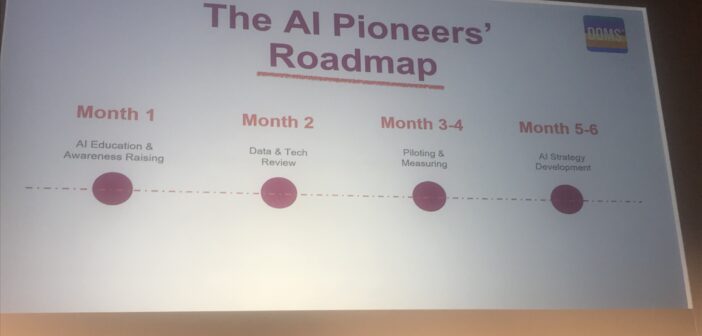No this wasn’t the title of the opening keynote at this year’s World of Learning Conference, but it was the focus of Dr Philippa Hardman‘s talk.
After giving a brief history of artificial intelligence, Hardman, a researcher into learning and AI, laid out the challenge for L&D teams now that generative AI has landed.
Currently most learning organisations – inhouse and suppliers – are using AI to generate more content, more quickly and at lower cost. But this does not represent the bigger opportunity of AI, says Hardman.
“Many of the AI tools are oiling a machine that already exists – doing content quicker, faster and cheaper. But efficiency is only a tiny part of what AI has to offer us,” she told delegates. “AI provides us with an opportunity to create a new model for learning.”
And that new model of learning is needed because of the challenges facing learning teams. Hardman shared some stats about those challenges.
- $370.77 billion was spent on workplace training in 2022, but only 12% of employees apply what they learn in their jobs*
- 60% of the global workforce will need reskilling in the next 5 years
Her own research into corporate learning shows that L&D challenges centre around four areas:
- Resource and prioritisation
- Instructional design skills
- Broken methods and tools
- Pace and agility

And to cap it all, L&D faces the wicked problem of the most effective form of learning, mastery learning, not being scalable.
Hardman shared a slide that showed mastery learning is significantly more effective (67% workplace transfer) than off the shelf and custom learning (12% workplace transfer). The 67% stat is based on an (unpublished) meta study of research on mastery learning.
But, custom learning, which is slow and expensive to produce, is by far the most popular form of learning for L&D teams, according to Hardman’s research.

So, how can L&D teams solve this wicked problem of creating and scaling the most effective form of learning when it is so reliant on expensive custom learning or off-the-shelf learning?
AI-powered L&D, says Hardman. She shared her thinking in the following slides, explaining how AI can transform the approach to learning and what this will mean for the L&D team.


To get started now, Hardman suggested using AI to define the highest value training based on employee data and KPIs so that L&D can prioritise L&D activity. And then use AI to design learning. Her research into using an ‘AI learning designer’ shows a 94% reduction in time to design, 92% reduction in cost of design per learning hour and a 96% increase in design quality.
AI could be used to ingest all learning content and then provide more accessible content (as we are already seeing from some learning technology providers).
Beyond this, Hardman explored the idea of AI as a work coach for individuals, something she is working on currently. The aim is for the AI to be the best person to talk to about doing your job, supporting you with a mastery learning experience.
And for L&D teams, this also means getting ready for a new member of the team – your AI L&D professional. “You will be in charge of the AI to make sure it is the ‘best L&D professional’,” Hardman says.
Other conference insights
Cathy Hoy, CEO, CLO100, shared her tips for marketing L&D. As well as providing some practical marketing tips, Hoy urged delegates to revisit the fundamentals of the L&D brand. This means looking at:
- What you want to be known for as an L&D team
- Aligning with organisational goals
- Creating a brand for L&D – Hoy shared Jeff Bezos’ definition of a brand – Your brand is what other people say about you, when you’re not in the room.
The first point sparked some interesting discussions. One delegate said employees wanted to get on with their jobs, not be marketed to by L&D. One response to that was to consider rebranding L&D as the function that helps people get their work done.
Understanding what the L&D team is known for is really important when creating the brand it wants to be/to become. The process of finding out gives L&D the opportunity to ask colleagues and stakeholders (internal and external) how they see the team’s role, what you do, your value and impact. This is the basis for aligning with the business and employees.
We also discussed the role of word of mouth as a marketing tool. This was something Adam Lancaster, former director of leadership at Meta, spoke about at Learning Live. If a product or service is useful and relevant and has a positive impact for people, then they will share it with colleagues. But the product has to be good, and this is where I diverge from the idea that marketing is the answer for L&D teams looking to drive engagement.
Poor learning resources are poor learning resources no matter how much you market them to employees, so ensure you create learning resources that are needed, in the right format and at the right time.
In the final conference session I attended, I heard about how Lucy Davies , head of learning at Heathrow, makes audiences care. It turned out that Davies worked with Nick Shackleton-Jones and his 5di toolkit to build a leadership programme for 1,700 leaders to enable managers to reconnect to the organisation and to reconnect with each other.
The approach is grounded in research, which is used to understand and define the problem that is being solved. This was a key message from Davies, to really understand what the problem is, to get a rounded view of it from leaders and employees and to test out assumptions and how views align/don’t align across different audiences. What are the day-to-day challenges of different audiences, how are they common/different? Do these challenges shed light on a specific problem?
These insights fed into the design of the initiative which is now live across the organisation. Davies also highlighted the importance of Shackleton Jones’ affective context model of learning, with its focus on attaching emotional meaning (affective context) to information. This brings me back to the title of the talk. Emotional engagement with learning makes the learning more powerful. But learners will only engage if they care about the learning resources you create, so they need to relate to the work things/challenges they care about.
I was only at the event for one day but it was great to reconnect with so many friends and to hear some interesting and thought-provoking talks. And unlike Learning Technologies, the exhibition hall features a wide range of providers from niche specialist technologies to training venues and educational institutions.
My big take-away from the event is to continue to evaluate and re-evaluate the use of AI in learning. If Hardman’s vision of L&D is realised then we are set to have a completely different looking sector, different suppliers and L&D teams with different skills. Whether or not that becomes a reality, it is up to everyone in the sector to engage with the technology and to get to grips with what Hardman describes as the “weird, wonderful and unsettling world of AI”.
* The stat in the article links to a piece of research from 2015 by 24×7 Learning, but I can’t find the full data – I’ll carry on searching!




